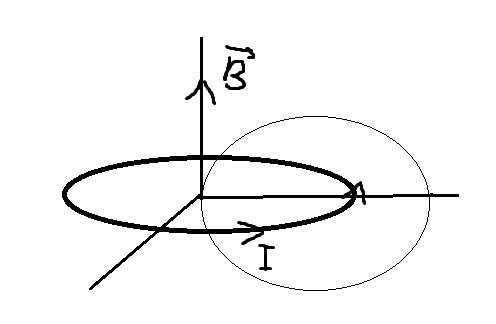[Physics and EE #4] Difference between Math and Physics
Difference between Math and Physics

Many of us just think physics as subfield of mathematics. But it is totally wrong. I will explain why.
1. Original Ampère's Circuital Law

In physics, Maxwell's Euqations are the four fundamental equations in electromagnetism. Among those, the Ampère's law, is stated as follows.
Ampère's Law - [3]
If is a closed loop enclosing a current
, then up to a constant, the current through the loop is euqal to the circulation of the magnetic field around
. To be precise,
Here we assume that is oriented so that
and
are related by a right-hand rule.
When Maxwell examined the original form of Ampère's Law above, he found that it was invalid for time varying electric and magnetic fields. If we restate the above original Ampère's Law in differential form, we get
where is the current density, and using Stoke's Theorem,
we finally have
2. What is Wrong?
2-1. Equation of Continuity [4]
First, recall what we've done in Fluid mechanics. Suppose a fluid of density flows with velocity vector field
in a solid region
in space enclosed by a smooth surface
. Then if there are no sources or sinks in the region
, the rate of fluid flowing into
should equal to the rate of fluid flowing out of
. The rate of fluid flowing into
is
and the rate of fluid flowing out of is
Using divergence theorem, we get
so that
because the region was arbitrary.
2-2. Direct application to Current Flow
Current itself also can be considered as flow (of electrons), so that ,
is the charge density. And what we get is
2-3. So what is Wrong here?
If we assume is of class
, we have
. But by original Ampère's Law and continuity equation this is equivalent to saying that
so that it forces charge density to be constant over time (even if is time varying!) ; which is a serious flaw.
3. How do we Overcome this?
3-1. Mathematical Point of View [5]
First let's look at the differential form
If is time invariant (i.e steady flow), by original Amère's Law , it is equal to zero. If
varies over time, it should be non-zero. Hence, introducing an aribtrary vector field
by setting
will solve the issue. Observe that when
is time invariant.
Now, take the divergence. Using continuity equation,
Also using Gauss's Law,
so that
Then most general form would be
where is any divergence free vector field,
. So in purely mathematical sense, the modified Ampère's Law would be
3-2. Physical Point of View [6]
So the question reduces to
Can we specify the vector field ?
In complete mathematical sense, as long as it satisfies divergenceless, it can be nonzero. But
Ampère's Law is a law in physics not in mathematics!
So the arbitrariness of is not the ultimate solution. Specification should be done in purely physical sense - by the experiment. Since no one has observed any physical evidence for
(and that's what Maxwell did in the past), it is assumed to be
, which then reduces to modified Ampère's Law in Physics,
4. Conclusion
What it tells us are the following. A law in physics should not only be mathematically precise but also should fit with experiments and real nature.
is totally true in mathematics, but NOT in physics.
5. Citations
[1] https://www.quora.com/How-does-one-understand-Amperes-circuital-law-in-a-practical-sense (only image is used)
[2] https://physics.stackexchange.com/questions/127144/amperes-law-and-biot-savart-law-gives-different-terms-for-magnetic-field-in-mid (only image is used)
[3] Clerk Maxwell, James. "On Faraday's Lines of Force".
https://archive.org/stream/scientificpapers01maxw#page/n193/mode/2up
[4] http://bolvan.ph.utexas.edu/~vadim/Classes/15s/contin.pdf (Page 1 through 4)
[5] https://www.u-cursos.cl/ciencias/2015/1/MC-330/1/material_docente/bajar?id_material=1082333 (Chapter 7, Section 4, Vector Analysis, Exercise 5 and 17-(a), (b))
[6] https://www.u-cursos.cl/ciencias/2015/1/MC-330/1/material_docente/bajar?id_material=1082333 (Chapter 7, Section 4, Vector Analysis, Exercise 5 and 17-(c))
:thumbsup:
Mathematics is essentially about possible measurements. As the criterion is consistency. Physics is about natural existence - what's actually measured by observers. (DeWitt, Clifford Truesdell, John Wheeler, Dirac have essays on the subject.) Nature being any subset of all that exists - the universe.
That meanwhile indeed is the reason Dirac's favorite approach of physical interpretation of mathematics works well or at all: what is not measured does not exist. (It has no behavior - does not induce a dynamic on any other system in the universe.) So the "unreasonable" effectiveness of pure (invariant to realizations) consistent speculation is simply that mathematics is a theory of measurement operations as they may be combined; physics is a theory of existence. They are intimately related - more than by random coincidence. Yet not the same. What can be measured is not necessarily measured. It's merely possible. Existence is more than that.
Yet this is therefore far more likely than random guessing at being correlated the truth - which is a map of things that do exist.
But indeed while all physical propositions are therefore a proper subset of all mathematical propositions, physics is not a proper subset of mathematics, not a part of mathematics, but mathematics is an important tool, one among many in a toolbox, in physics and physical reasoning.
For example, how much of http://www.math.harvard.edu/~lurie/papers/HA.pdf is physically meaningful? When you think about it, quite a lot. Not all - but a lot. Essentially the subject would be measurements where information is not fundamentally lost, even when coarse measurements, ones at higher granularity, are performed and reasoned about.
Thanks for the comment!
Hey @tibra
Here's a tip for your valuable feedback! @Utopian-io loves and incentivises informative comments.
Contributing on Utopian
Learn how to contribute on our website.
Want to chat? Join us on Discord https://discord.gg/h52nFrV.
Vote for Utopian Witness!
Yes physics and mayhematics are not the same, and also it is ture that physics is not a subset means subcategory of mathematics.Both are different and both need each other to verify their laws and problems.
A good post like always, keep it up friend!
Thanks. I will do my best to post quality materials on steemit.